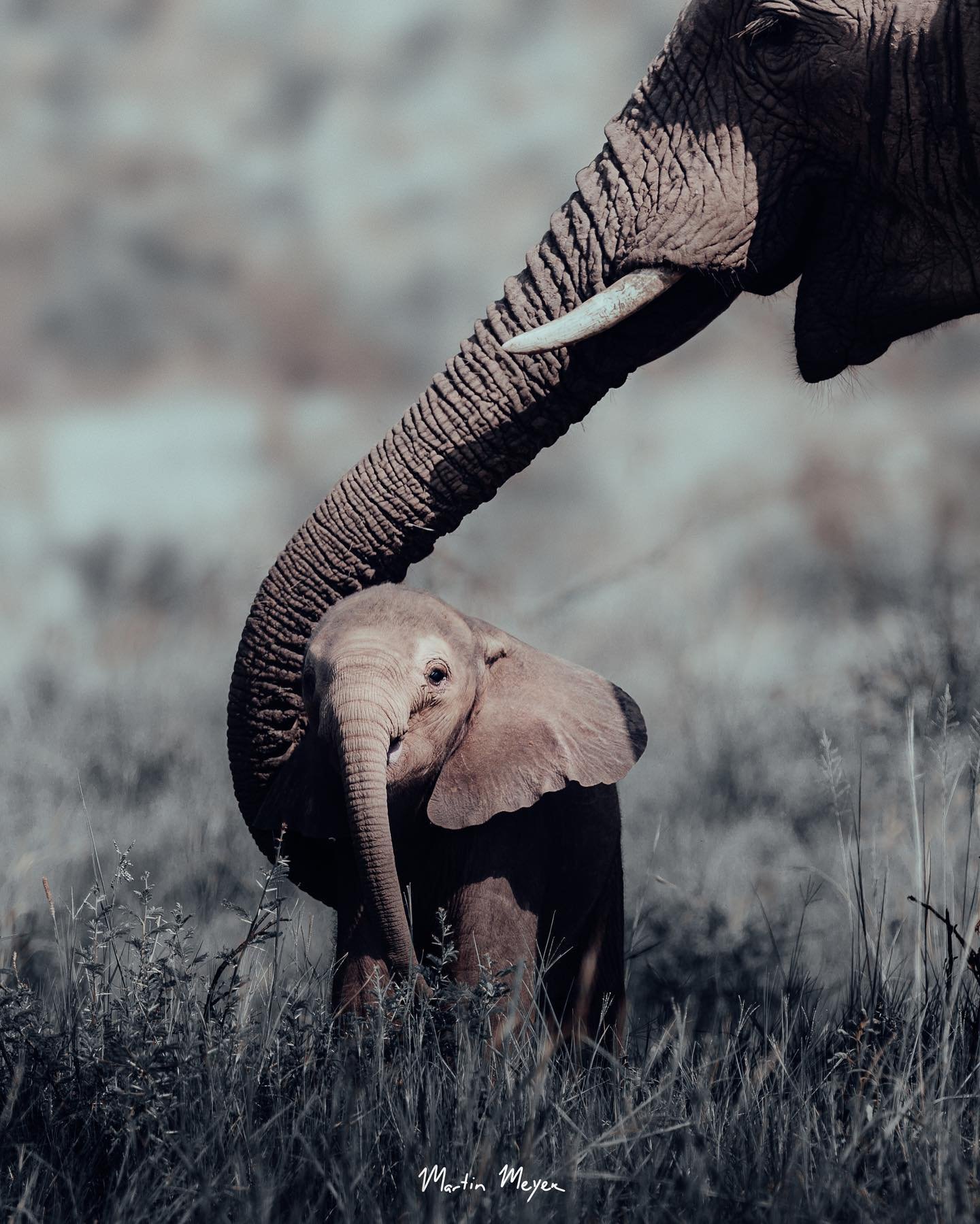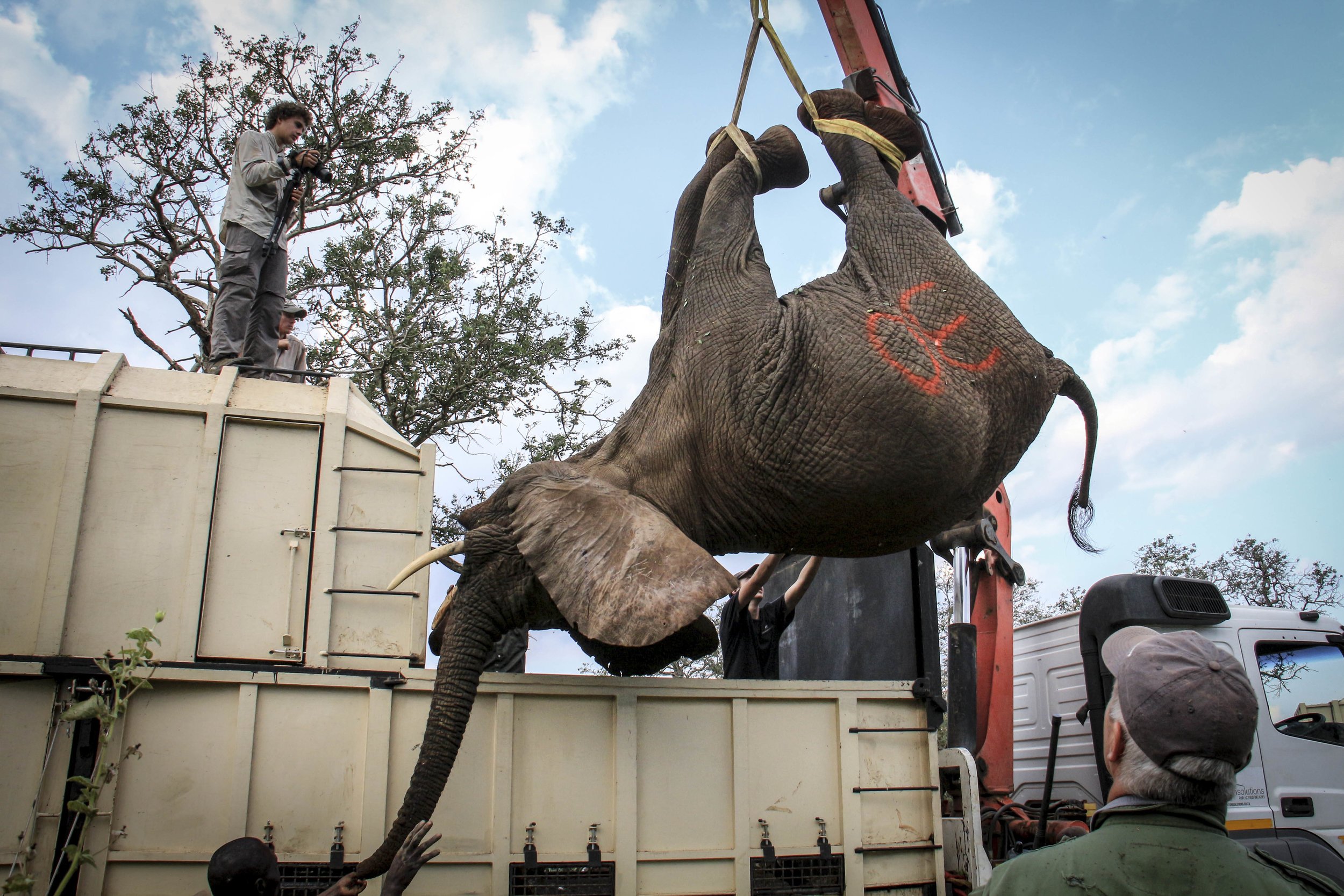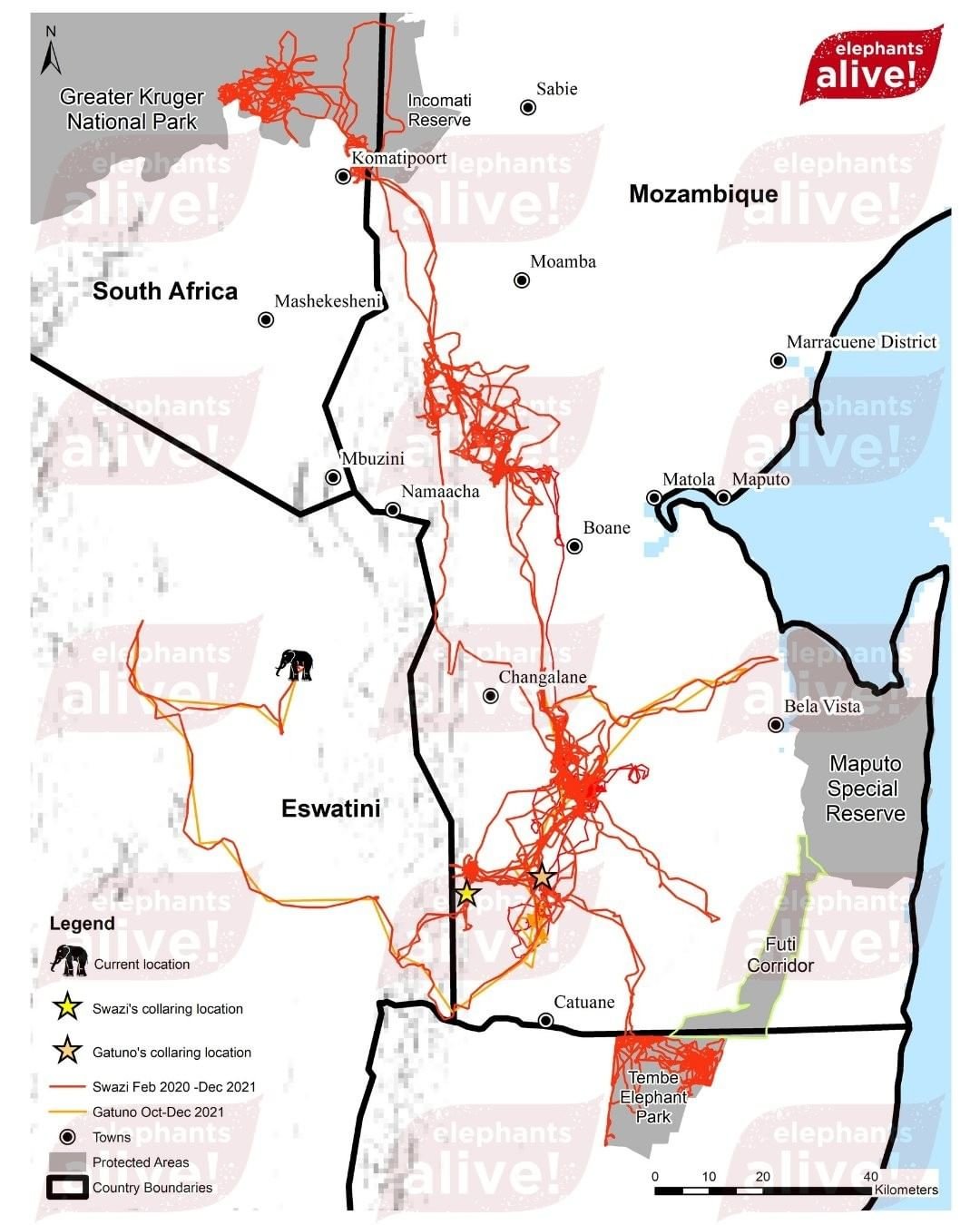WILDLIFE CORRIDORS: SAFE CONNECTED SPACE FOR ELEPHANTS
It’s #WorldElephantDay each year on August 12th, and this year, we highlight the less-talked about conservation issue for African elephants: the need for corridors. Recent daring and dangerous journeys of elephants in South Africa and China have brought attention globally to the need to connect wild spaces with corridors, to give elephants safe passage to migrate and move. Learn more about elephants and the need for connective corridors in our latest blog post below.
African Savanna Elephants on the move. Photo credit: Shannon Wild / Wildscreen Exchange
A mother elephant gently moves her calf out of harm’s away. Photo by our Ambassador, Martin Meyer
The elephant has captivated human imaginations and hearts across the centuries. Like us, they love their families and care for their babies as the most precious members of the herd. They are intelligent, social, emotional, respectful of ancestors, playful, self-aware, and compassionate. These are just some of the words that researchers have used to describe observations of elephant behavior in the wild. Perhaps that is why, of all the incredible species in the vast array of life on our planet, elephants are an animal that humans tend to gravitate towards. They are the “E” in our children’s books, the soft toy that our babies cuddle. And yet, on our watch, they are disappearing from our planet, edging closer to extinction. How can we imagine a world in which wild elephants no longer exist?
But this diminished world is close at hand.
In the 1920s there were estimated to be around 10 million elephants in Africa. By the late 70s, only 1.3 million elephants remained according to the first pan-Africa elephant survey. Today, after the results of the Great Elephant Census in 2016, we know that only around 400,000 elephants remain in Africa. The two species of elephants in Africa, are now both officially closer to extinction: the African savanna elephant is now officially endangered and the African forest elephant is critically endangered.
As an endangered species, elephants in Africa face multiple threats. While poaching is the headline issue for elephants, they face a larger challenge (literally). In our region, southern Africa, the key conservation challenge for African elephants is - simply- they are running out of wild space. Wildlife reserves are fenced, and elephants are cut off from exploring their wider landscape, stopped from migrating and wandering in search of new horizons, new mates, water, and food. This poses challenges to the genetic diversity of elephants, their ecosystems, and their survival in a climate-changed future.
African elephants need to be able to move to find resources during drought and to leave conflict areas. Climate change accelerates the need for protected areas to be connected by corridors. Photo credit: Shannon Wild
Reserve managers in South Africa face difficult choices in managing elephant populations. The first option is contraception, used to slow breeding rates, but this intervention isn’t always effective. The second option is to increase the size of their habitat. This is done by connecting reserves via wildlife corridors or expanding existing reserves - which is the focus of Wild Tomorrow Fund’s work saving habitat in KwaZulu-Natal - but this takes time and large amounts of funding. If contraception and habitat increases are unsuccessful then only two options remain: relocating elephants to other reserves or the tragic option of last resort - culling.
Elephant translocations are expensive, and returning elephants to a reserve where they had been poached out in the past is a grave responsibility. Conservationists must first ensure that the destination is safe and adequately protected, that it is large enough for elephant numbers to increase, and that the habitat meets the ecological needs of elephants.
In 2018, Wild Tomorrow Fund was part of a large operation to move 53 elephants from two over-crowded government reserves in our region of South Africa to Zinave National Park in Mozambique, 777 miles away. This is elephant #30 being lifted into the transport truck. Photo credit: iSimangaliso Wetland Park.
Moving elephants is an unnatural process.
Before fences and political boundaries were constructed by humans, elephants were more easily able to relocate themselves, moving to follow water sources and find mates by following old pathways known by their elders. In the absence of natural safe passages, now lost to roads, agriculture, mines, and human settlements, conservationists must intervene to help them cover the distance safely. Translocations have been called ‘virtual corridors’, with humans creating a safe, manufactured pathway for elephants in the absence of a natural safe corridor. Elephants are sedated (darted by a sharp-shooting vet from helicopters), lifted into the sky, and moved by trucks over hundreds or thousands of miles to their new destination. In 2016, African Parks completed the largest elephant relocation in history, moving 500 elephants from two over-crowded national parks in Malawi to a newly secured park in the north of the country, where elephants had previously been poached out. This month, African Parks moved Malawi’s elephants again, this time another 263 elephants were moved 350 kilometers (217 miles) from Liwonde to their new home in Kasungu National Park, at a cost of over $1 million dollars.
Elephants braving their own paths
While electrified fences in South Africa aim to keep elephants safely inside protected areas, some young bulls (and sometimes females too) become trailblazers, seeking their own territories, and breaking through electric fences. They are the wanderers, the escape artists.
Elephants Alive, a non-profit based in Limpopo South Africa, has been researching collared elephants for over 25 years - tracking data to monitor their incredible journeys. Collared elephants enable us to follow their footsteps, virtually, through fences and across park boundaries, telling a story of survival every step of the way as they navigate their way through human-dominated landscapes. If we allow them, elephants will show us where protected area expansion should occur.
This year in South Africa, 11 male elephant bulls went on a dangerous journey that captivated the attention of conservationists, traveling 800km across three countries, starting in southern Mozambique, traveling through eSwatini (Swaziland formerly) to Mpumalanga where they reached the Kruger boundary. One of the elephants, nicknamed Trail Blazer, was collared, allowing us to follow the group’s passage, headed together to Trail Blazer’s original home inside Kruger National Park. The last part of their journey was the most dangerous as they were shot at soon after entering South Africa. This ordeal resulted in them temporarily splitting up before regrouping to continue their journey north.
Swazi, an elephant collared and monitored by Elephants Alive, travelled from Tembe Elephant Park in nothern South Africa, through Mozambique, in and out of eSwatini, and up to Greater Kruger National Park - a journey of 5830km so far (over 3600 miles). Image: Elephants Alive. See the full story on their Instagram feed here.
Trail Blazer’s daring path, tracking him via his collar from Mozambique, through eSwatini, and into South Africa, and finally to the border of Kruger National Park. He and 5 remaining bulls with him were then transported by truck into the northern area of Kruger where they have settled…for now! Image credit: Elephants Alive.
Trail Blazer found his way to his old stomping ground, Kruger, only to pace up and down along the fence, the last barrier in his way. Thankfully, Trail Blazer and 5 remaining bull elephants who were with him were darted and safely relocated across the fence, transported by truck to the northern end of Kruger National Park. Of the original group of 11, one bull was badly injured in conflict with people and had to be euthanized. The other 6 bulls ended up lost, unable to find the group after being shot at and running away in a panic. They are not wearing collars, but are still out there somewhere, trying to navigate a very fragmented landscape across protected and non-protected areas, perhaps headed back to Mozambique and the safety of the parks they remember.
Research has shown that elephants in conflict areas start hiding by day and traveling/foraging at night to avoid the threat of humans while we are sleeping. They use sounds, gestures, infrasound (via vibrations in their feet), and even chemical secretions to enable them to communicate across distances and stay safe! It helps explain why they have not yet been located. We hope they make it home (or to a new home) safely.
And it’s not just a story of searching for safe wild places amongst shrinking, fragmented habitats in Africa - the same issues echo around the world for all wildlife - including wild Asian elephants. With only 40,000-50,000 left in the wild, the Asian elephant species is also listed as endangered. Last year, the journey of a herd of 15 wandering Asian elephants in southern China captured the hearts of people in China and around the world. Captivating drone images showed these wandering elephants asleep, ‘cuddled’ together in a connected group of trunks and bodies, with their calf safely in the middle, the only one awake amongst a protective circle of adults. They traveled over 500km through populated areas, along roads, breaking into shops, and ‘stealing’ food and water from farms, only to return back to their home reserve after their long, exhausting journey.
The local government in China went to great lengths to protect these precious elephants, deploying 14 drones and 500 people to keep the herd safe. Eight people acted as constant bodyguards tracking them 24 hours a day and working to lead them away from densely populated areas by providing over two tonnes of tempting elephant food where needed. Entire villages were ordered to evacuate ahead of the elephants when they couldn’t be diverted
Chinese State TV set up a 24-hour live feed to follow their every move, with the hashtag #WhyElephantsTrekkingNorth viewed more than 16 million times on Weibo. Drone footage of them sleeping, shown in the Youtube video above, attracted 200 million views per day. It was an unprecedented journey in China, with an unprecedented audience, with millions of people wondering where they were headed, and wishing them - and their babies - safe passage. They reminded us of our own families, cuddling together for warmth and comfort on a stressful, exhausting journey, as we wondered - where are they going?
Why did these elephants embark on such a dangerous long journey?
While the exact catalyst of their dangerous migration is debated, one answer is simple and reflects the same major challenge facing elephants in Africa: habitat loss and fragmentation. In the last two decades, wild elephants in China have lost 40 percent of their southern Yunnan habitat to development. The region where these elephants live is home to China’s largest tropical rainforest, but much of it has been cleared for exotic rubber tree plantations. This puts strain on already scarce food resources. These smaller elephants need to eat up to 200kg of food every day. Their loss of habitat and as a result, access to adequate food, may have encouraged them to migrate, even when some were pregnant (a risky time to travel), in search of safe spaces with food. Perhaps their 17-month journey was one that taught them there is no safe space to the north, where they originally headed. Did they draw on the memories of their elders, seeking a wild place that no longer exists? It’s a heart-breaking thought, one that urges us to protect spaces for elephants.
For #WorldElephantDay this year, these stories of wandering elephants, facing danger at every turn, highlight the important story of habitat loss and the need for connected safe space via corridors. We, humans, love to love elephants while they are simultaneously being forced closer to extinction due to our hunger for their ivory and our unceasing appetite for development (and our increasing populations).
To put the issue in stark perspective: in China, with a population of 1.45 billion people, only 300 wild elephants remain; in Africa, with a growing population of 1.4 billion, less than 400,000 wild elephants remain. No individual wild elephant in Africa or Asia is safe from the expanding range of humans, and the conflict that follows us. With the global human population expected to grow over 25% from 2019 to 2050 (along with the associated increase in human footprint), there is an urgent need for development scenarios and land-use planning that takes wildlife and human needs into account to secure corridors, essential for the long-term survival of elephants.
Saving elephants means not only stopping poaching. We must work together across boundaries and international borders to reconnect corridors to the places and paths they once knew.
A world without wild elephants would be one that is vastly diminished. Wild Tomorrow Fund is playing a part in the protection of elephants in southern Africa. Our wildlife corridor will reconnect old pathways they may still remember. Once the fences at the Greater Ukuwela Nature Reserve come down, will the elephants next door at Phinda Private Game Reserve immediately cross our river to find the freshwater springs on our reserve? It will be fascinating to watch them explore this landscape that elephants have been cut off from for at least 30 years or more.
To save elephants and all wild things, we must stop the poaching, the decline, and the destruction of their habitats. But to have hope for their future, we must connect, restore and expand the wild spaces they have left. Elephant survival depends on these wild spaces – and therefore, they depend on us!
To support our habitat conservation program, please consider donating today in honor of elephants and their families for #WorldElephantDay2022.
Elephant Mother and calf, walking. Photo credit: Shannon Wild / Wildscreen Exchange.
References
Chase MJ, Schlossberg S, Griffin CR, Bouché PJC, Djene SW, Elkan PW, Ferreira S, Grossman F, Kohi EM, Landen K, Omondi P, Peltier A, Selier SAJ, Sutcliffe R. 2016. Continent-wide survey reveals massive decline in African savannah elephants. PeerJ 4:e2354 https://doi.org/10.7717/peerj.2354
2016. African Parks. 500 Elephants: An Extraordinary Journey. https://www.africanparks.org/campaign/500-elephants
25 Mar 2021. IUCN. African Elephant Species now endangered and critically endangered. https://www.iucn.org/news/species/202103/african-elephant-species-now-endangered-and-critically-endangered-iucn-red-list
11 May 2021. SA People. Incredible Journey of Meandering elephants ends at Kruger National Park: 5 relocated, 6 missing. https://www.sapeople.com/2022/05/11/incredible-journey-of-meandering-elephants-ends-at-kruger-national-park-5-relocated-6-missing/
25 May 2021. New York Times. Some Elephants in Africa Are Just a Step From Extinction. https://www.nytimes.com/2021/03/25/science/elephants-africa-endangered.html
9 June 2021. David Henning. China’s Marauding Elephants https://www.getaway.co.za/travel-news/chinas-marauding-elephants/
9 August 2021. The Guardian. China’s herd of wandering elephants finally heads for home. https://www.theguardian.com/world/2021/aug/09/chinas-herd-of-wandering-elephants-heads-yunnan-reserve







